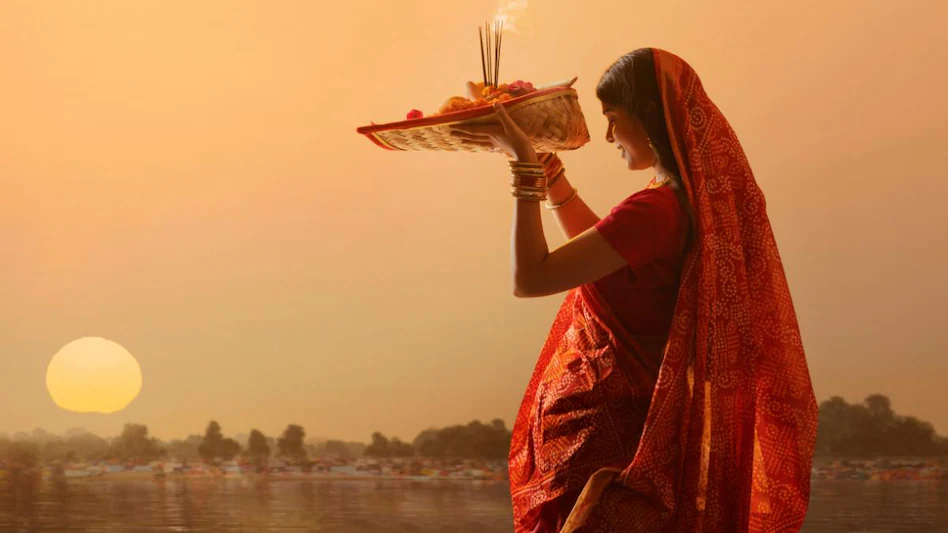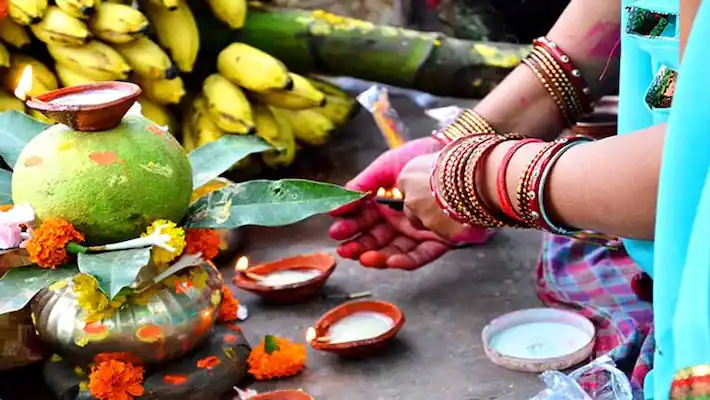Chhath: The Purvanchali Maha Parv
Blogs Home
- 03 Nov 2022

A few days ago, one of the most significant festival of Chhath was celebrated with much pomp and enthusiasm in North and North-eastern Indian States of Bihar, Uttar Pradesh, Jharkhand and even parts of Bengal.
Since my childhood, I have seen women in my family celebrating the Maha Parv- Chhath with great zeal. My relatives from all over the world used to travel to our native town to attend the Pooja, and it always intrigued me why among all the festivals we celebrate, this one held the most significance.
As a child, I was told different stories of how performing this Pooja fulfilled people’s desire to have a child or how miraculously this Pooja helped cure diseases that even doctors failed to heal. My grandmother shared her personal experience when my grandfather was bedridden and how he recovered from an undiagnosed ailment once she started the Pooja.
As I grew old, I read about the Pooja, and it was then that I realised its importance, cultural richness, and how old of a ritual it is, and now I can very proudly take a chance to tell how and why we celebrate the Chhath Pooja.
How old is the Maha Parv?
Chhath is derived from the Sanskrit word Shashthi, which means the sixth. That’s why it is celebrated after six days of Diwali or on the sixth day of the month of Kartik.
The goddess worshipped during Chhath pooja is known as Chhathi Maiya. She is mentioned as Usha in the Vedas and is believed to be the beloved younger wife of Surya, the Sun God.
Chhath Pooja stems from the early Vedic periods. Chhath has references in the Rig Veda. Sages from the Vedic era started performing the Pooja to thank the Sun god for bestowing the bounties of life on earth. Chhath also has an association with Ramayana and Mahabharata.
According to some legends, Goddess Sita and Lord Rama performed the Pooja in the Munger district of Bihar after returning from their exile. At the same time, Kunti performed it to have a son who was later born and named Karna. Draupadi, too, performed the Pooja to get back their lost kingdom. These folklores made the Pooja very popular in the country's northern region, especially in the states of Bihar and Uttar Pradesh.
The grand celebration of the Chhath Pooja
Chhath Pooja’s four-day celebration begins with Naha-Khaye; the Pooja begins with the devotees taking a holy bath followed by deep cleaning the houses and cooking of Satvik prasad, often Lauki-Bhaat (bottle gourd and rice) with daal. It is first served to the deity, which is the last meal the devotees usually eat until the Pooja ends on the fourth day.
The second day of the pooja is called Kharna. On this day, the devotees and their families make kheer (a sweet dish prepared with rice, milk and spices) on an earthen stove. This kheer is then eaten by the devotees and their families in the evening after doing a paath (recitation of holy scriptures). It is said that God arrives to reside at their devotees' place for the next two days, and if any noise is made, then they leave the premises.
The third day commences with the preparation of the prasad and decoration of the ghats. Thekua is the most popular prasad that is made only during this pooja. Along with Thekua, seasonal fruits are arranged in bamboo baskets. Devotees then leave for the ghat. Family and friends accompany them. The male members usually hold the baskets, and some even perform dant by rolling on the street and cleaning it for the devotee to walk.
The devotee prays while standing in the water and the family and friends offer Gangajal (water of the holy river Ganga) to the Sun God. This offering of Gangajal is called Aragh.
When the sun sets, people return to their homes and sing songs praising the Sun God and Goddess Usha.
Finally, on the last day of this Pooja, the devotees and their families go to the ghat before sunrise. After praying to the Sun God, family and friends offer milk and Gangajal as Sragh on sunrise. After the pooja, the devotees drink water and eat prasad marking the end of the long fast. This entire procession is also witnessed by many onlookers who come to seek blessings from the devotee and take prasad.
Chhath Pooja and its impact on the environment
Ashok Ghosh, chairman of the state-level expert appraisal committee of State Environment Impact Assessment Authority, said that the message of nature conservation is best spread among the masses in Bihar and elsewhere through Chhath.
Every living being is directly or indirectly dependent on Solar energy, and it is the Sun God who is worshipped during Chhath. The worship of the Sun God and every ritual followed during Chhath revolves around nature.
The festival begins with cleaning the rivers and river banks, where the devotees perform the pooja. The family members decorate the ghats using flowers and sugarcane. Offerings made to the deity consist of fruits and sweets, which are all biodegradable.
Not just that, the offerings are to be served in baskets made of bamboo, locally known as daura and soop. The offerings made during the pooja are also supposed to be made of chulha (earthen stoves).
Another aspect of this festival worth appreciating is that it doesn’t involve idol worship, which once again negates the possibility of polluting the rivers. Chhath also emphasises greatly on not using artificial materials, which can harm the environment in any possible way.
In the current scenario where the need of the hour is to conserve the environment, Chhath pooja teaches us how to balance environment with religious practices. I have seen my family members digging a small pit to bury all the waste left from the Pooja; since all of it is degradable and causes no harm to the environment.
Chhath Pooja and its cultural aspect
Chhath, being related to worship of the Sun, establishes a direct connection between the devotee and the God. Thus no priests are involved in the performing of the entire ritual.
After Diwali, one can sense a different wave of excitement in families where Chhath is celebrated. Trains and planes are packed with devotees and their families, thus bringing everyone together for the celebration of this Maha Parv.
Earlier, the festival of Chhath was celebrated only in a few parts of Northern India, predominantly Bihar, eastern Uttar Pradesh, and West Bengal. But for a few years now, it has been celebrated nationally and the migrants have popularised this Pooja internationally. Chhath is also celebrated in Nepal, specifically in Lumbini and Madesh.
This pooja is a beautiful example of an inclusive society. Irrespective of caste, creed and class, devotees stand to gather at the ghat to offer Aragh. It’s a classic example that everyone is the same in the eyes of God, and what is even more beautiful is that this message was delivered from the old times.
The sight of ghats at Chhath Pooja teaches us how to live in harmony and how beautiful a society can be if there isn’t any discrimination.
Is Chhath gender-neutral?
While the females of the family mostly perform Chhath, a lot of males perform fasting and Pooja. It is so because, according to tradition, once someone in the family starts this pooja, the entire family is bound to perform it yearly.
So in the absence of any female member or if the females are not well, then male members can continue the tradition. Not only this but there has been a growing trend where males do this pooja for the well-being of their kids and family.
Chhath is gender neutral because not only does the devotee perform the rituals alone, but the entire family helps perform this pooja. Males carry the heavy fruit-laden baskets to the ghats, and many perform dant to keep the path of the devotee to the ghat.
Politics and the Maha Parv
Chhath is a unique festival and is performed with the highest sense of devotion but just like any other aspect of our lives, even this festival has lately been politicised, and different political parties are leaving no stone unturned to turn this festival and emotions attached to it into vote banks.
Last year, in Delhi, specific orders were issued prohibiting the observance of Chhath pooja on the banks of the Yamuna on account of increasing pollutants in the river. This led to the resurrection of politics over the festival.
Incidents such as these point out that political parties do politics in the name of religion, forgetting that this interference would hamper the sanctity of this pious festival.
Conclusion
Chhath is a ceremonious conclusion to the festival season in our country. Chhath pooja is a beautiful example of a society that is inclusive; a community that lives and enjoys together without discrimination of any sort, cares for the environment and prays in the simplest way possible.
This Pooja focuses extensively on keeping the environment clean and teaches us that it's not necessary to harm the environment to celebrate and worship. In modern time, where religion is intermingled poorly with business and politics, Chhath is an example of how one can worship the Almighty by following simple rituals. These are a few reasons Chhath has gained immense popularity in the recent years.

Harshita Rai
Harshita Rai, is a law graduate. She has a diploma in IPR from Indian Law Institute, Delhi. She was a researcher in a reputed law firm in Jaipur and her research papers have been published in NHRC and FYLC national seminar. She is a voracious reader.
Blogs Home







